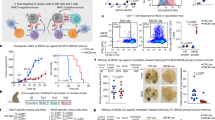Abstract
The tumour-suppressor gene p53 is pivotal in the regulation of apoptosis, and point mutations within p53 are the commonest genetic alterations in human cancers. Cytotoxic T lymphocytes (CTL) recognise peptide-MHC complexes on the surface of tumour cells and bring about lysis. Therefore, p53-derived peptides are potential candidates for immunisation strategies designed to induce antitumour CTL in patients. Conformational changes in the p53 protein, generated as a result of point mutations, frequently expose the 240 epitope, RHSVV (amino acids 212–217), which may be processed differently from the wild-type protein resulting in an altered MHC-associated peptide repertoire recognised by tumour-specific CTL. In this study 42 peptides (37 overlapping nonameric peptides, from amino acids 193–237 and peptides 186–194, 187–197, 188–197, 263–272, 264–272, possessing binding motifs for HLA-A2) derived from the wild-type p53 protein sequence were assayed for their ability to stabilise HLA-A2 molecules in MHC class I stabilisation assays. Of the peptides tested, 24 stabilised HLA-A2 molecules with high affinity (fluorescence ratio>1.5) at 26 °C, and five (187–197, 193–200, 217–224, 263–272 and 264–272) also stabilised the complexes at 37 °C. Peptides 188–197, 196–203 and 217–225 have not previously been identified as binders of HLA-A2 molecules and, of these, peptide 217–225 stabilised HLA-A2 molecules with the highest fluorescence ratio. Peptide 217–225 was chosen to generate HLA-A2-restricted CTL in vitro; peptide 264–272 was used as a positive control. The two primary CTL thus generated (CTL-217 using peptide 217–225; and CTL-264 using peptide 264–272) were capable of specifically killing peptide-pulsed T2 or JY cells. In order to determine whether these peptides were endogenously processed and to test the hypothesis that mutants expressing different protein conformations would generate an alternative peptide repertoire at the cell surface, a panel of target cells was generated. HLA-A2+ SaOs-2 cells were transfected with p53 cDNA containing point mutations at either position 175 (R → H) or 273 (R → H) (SaOs-2/175 and SaOs-2/273). Two HLA-A2-negative cell lines, A431 and SKBr3, naturally expressing p53 mutations at positions 273 and 175 respectively, were transfected with a cDNA encoding HLA-A2. The results showed that primary CTL generated in response to both peptides were capable of killing SaOs-2/175 and SKBr3-A2 cells, which possess the same mutation, but not SaOs-2/273, A431-A2 or SKBr3 cells transfected with control vector. This suggests that these peptides are presented on the surface of SaOs-2/175 and SKBr3-A2 cells in a conformation-dependent manner and represent potentially useful target peptides for immunotherapy.
Similar content being viewed by others
Author information
Authors and Affiliations
Additional information
Received: 23 March 2000 / Accepted: 22 June 2000
Rights and permissions
About this article
Cite this article
McArdle, S., Rees, R., Mulcahy, K. et al. Induction of human cytotoxic T lymphocytes that preferentially recognise tumour cells bearing a conformational p53 mutant. Cancer Immunol Immunother 49, 417–425 (2000). https://doi.org/10.1007/s002620000137
Issue Date:
DOI: https://doi.org/10.1007/s002620000137




